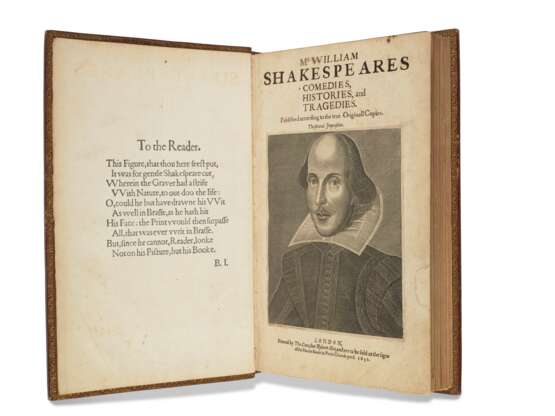ID 627622
Lot 133 | The Second Folio
Estimate value
$ 50 000 – 80 000
The Second Folio. Second edition, first issue, of Shakespeare’s collected plays, the most important work in the English language. The Second Folio contains for the first time Milton's anonymous epitaph to Shakespeare, the first of Milton’s English-language poems ever to appear in print. Shakespeare’s collected works are considered the most important and influential in the English language, described by Samuel Johnson as “the mirrour of life” and by his contemporary Ben Jonson as “not of an age but for all time.” The urge to read, rather than just see, Shakespeare’s plays surfaced in his own lifetime, with about half of his works appearing as single quarto editions. The First Folio, collecting Shakespeare’s plays for the first time and dividing them into the thematic categories of Comedies, Histories, and Tragedies was issued in 1623; this Second Folio, appearing nine years later, is a page-for-page reprint of the First Folio. While errors were introduced during the course of reprinting, “the text of the present edition shows signs of careful, if unauthoritative, revision” (Greg). Loosely inserted is a fragment bearing the signatures of Philip Herbert, 4th Earl of Pembroke (1584-1650, dedicatee of the First Folio), Sir Henry Mildmay (c.1593-1668) and Francis Rous (c.1581-1659), cut from a document of the parliamentary committee for the revenue, 13 June 1648, and mounted on card.
John Milton’s epitaph to Shakespeare in 16 verses, beginning “What neede my Shakespeare for his honour'd bones” appears under an 8-line verse “Upon the Effigies” on leaf A5r. This leaf and the title-page, with which it is conjugate, are recorded in various issues and states (cf. Todd), indicating which of the five publishers of the Second Folio was responsible for that allocation of copies. The present copy has the Effigies leaf in the first state, first issue, so it can be identified as belonging to the first issue and the allocation accorded to Thomas Cotes and others not named in the imprint (cf. Todd). Greg III:1113; Pforzheimer 906; STC 22274; W.B. Todd. ‘The Issues and States of the Second Folio and Milton's Epitaph,’ in: Studies in Bibliography V (1952-53), pp 81-108.
Median folio (327 x 210mm). 451 leaves, of 454 (first leaf [To the Reader] in facsimile, lacking A3 [dedication to the Earls], and *3 [verses by I.M.S.]. Roman and italic types. Double column, 66 lines, headlines and catchwords, pages box-ruled, woodcut head- and tailpieces and initials, engraved portrait of Shakespeare by Martin Droeshout in third state, supplied from a copy of the Fourth Folio (title cut down to portrait and window-mounted with all text supplied in pen-and-ink facsimile and with small marginal repair, scattered small, light stains, some light toning and a few leaves lightly browned, minor repaired tears in about 10 leaves, effecting a few letters in 4, tiny hole effecting a letter or word in 4 leaves, nn3 just short at fore-margin). 19th-century russet morocco gilt by Morrell (Frith St., London), gilt spine, gilt edges (hinges slightly rubbed); later cloth folding case. Provenance: dates 1700/1708 washed from nn3v – R.S. Williams (bookplate) – John Camp Williams (?1859-1929; booklabel).
| Artist: | William Shakespeare (1564 - 1616) |
|---|---|
| Applied technique: | Pencil |
| Artist: | William Shakespeare (1564 - 1616) |
|---|---|
| Applied technique: | Pencil |
| Address of auction |
CHRISTIE'S 8 King Street, St. James's SW1Y 6QT London United Kingdom | |
|---|---|---|
| Preview |
| |
| Phone | +44 (0)20 7839 9060 | |
| Buyer Premium | see on Website | |
| Conditions of purchase | Conditions of purchase |













